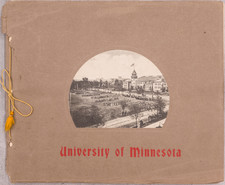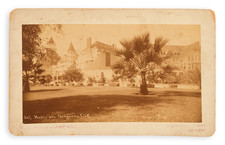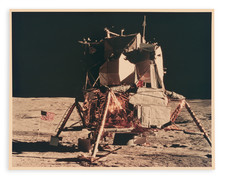Mammoth Plate Photograph by Carleton Watkins - Institutionally Rare
View of Cathedral Rock, Yosemite
"Carleton E. Watkins was a giant of photography. He is arguably America's greatest landscape photographer" - Palmquist & Kailbourn
An original mammoth-plate photograph of Cathedral Rock by Carleton Watkins, the outstanding 19th century photographer of the American West.
In 1861 Watkins began making his famous large-scale "mammoth-plate" photographs in California's Yosemite Valley -- iconic views that are now unanimously accepted as some of the most beautiful photographic images ever made in the West. These images were influential in persuading the United States Congress to pass pioneering legislation to preserve the Yosemite Valley, which bill, the Yosemite Valley Grant Act, was signed into law by Abraham Lincoln on June 30, 1864. This law granted Yosemite Valley and the Mariposa Grove to the State of California, "to be held for public use, resort, and recreation...[the use of which in this manner] shall be inalienable for all time." Watkins was consulted by Yosemite Commissioner Frederick Law Olmsted on the best means to preserve Yosemite as a public trust. It wasn't until 1890, through the efforts of John Muir and others, that Yosemite was signed into existence as the nation's third National Park.
While the technical and aesthetic qualities of Watkins's Yosemite photographs were early lauded by enthusiasts and experts alike, including William H. Brewer of the California State Geological Survey ("the finest I have seen"), J. D. Whitney (who named a 8,500-foot peak in Yosemite after Watkins), Edward L. Wilson (editor of the Philadelphia Photographer, who noted that "[Watkins's] camera is mightier than the sword") and Oliver Wendell Holmes (the foremost photography critic of the time who said Watkins's photographs reached "a perfection of art which compares with the finest European work"), it wasn't until the 1970s that Watkins was re-discovered by the photographic art world, thus shining a brighter light on his life and work. Watkins's mammoth-plate views of Yosemite are now solidly ensconced as part of the canon of fine art photography. Examples of Watkins's Yosemite photographs are in many great institutional collections, including the Bancroft Library, the Getty, the Metropolitan Museum of Art, the Huntington Library, and numerous other institutions.
According to Weston Naef, the present image was made by Watkins ca. 1865-1866, after a similar view from a slightly different perspective made in 1861, and likely others made in the iterim. Watkins often returned to the same locations in Yosemite, making numerous photographs of the same subject over time. Naef has described the present image:
This view looking across El Capitan Meadow represents Watkins's return to the site of cat. no. 155, with the adjustment of standing north-northeast of his previous position, with changes to the composition slightly.
Perhaps best understood as a transitional image, our photograph is significant in Watkins's evolving pictorial approach: here we see a hint of foreground at the base of Cathedral Rock beginning to open up something more expansive, yet it is not as fully opened as when the Merced River takes over the entire foreground in an entirely different view of the Cathedral. Another, apparently earlier version of Cathedral Rock, had no foreground:
The picture that was presumably the first Watkins took [in 1861] of Cathedral Rock includes no foreground, just the tops of some trees. Cathedral Rock itself fills about 85 percent of the frame. It is vaguely disorienting... he made another substantially different picture of the landscape that contains Cathedral Rock. The Merced River forms the entire bottom of the picture.... It's a composition of water, flora, sky, and geological formation, features unified into landscape - Tyler Green, Carleton Watkins: Making the American West, pages 93-94.
At some point Watkins began assigning his own catalogue numbers to his Yosemite photographs, with the present view conforming to CEW 19.
Mammoth-Plate Camera.
Watkins made the negative for this image using his custom made oversized camera. This camera was constructed by a local San Francisco instrument maker to handle negatives as large as 18 x 22 inches (the so-called mammoth-plate format).
Watkins's most famous visit to Yosemite Valley took place in the summer of 1861, when the photographer brought with him for the first time a special camera designed to accommodate sheets of glass 45.7 x 55.9 cm (18 x 22 inches) in size that were popularly called "mammoth plates." Exactly how Watkins procured this highly unusual oversize camera is uncertain. One possibility is that it was fabricated by someone such as Thomas Tennant, who advertised his services in Hutchings's magazine as an instrument maker on Battery Street in San Francisco. - Naef & Hult-Lewis, page 45.
Watkins's Autograph
According to Weston Naef and Michael Hargraves, the style and character of Watkins' handwriting evolved over time. Specifically, the way he formed the W in his name changed from having pointed bottoms to having curved bottoms. This change, which happened sometime in 1861 (or possibly as late as 1863), was accompanied by additional modifications to his signature marked by spaces where he lifted the pen from the writing surface at mid stroke. Oddly enough, by 1872 Watkins had reverted to the pointed-bottom W.
An aid to dating the photograph at hand. Naef and Hargraves state there are few prints with Watkins's autograph signature between about 1865 and 1875. This is because he was too busy in the field, carting around his mammoth-plate camera up and down the Pacific Coast, to be able to sign many prints.
The present photograph bears an autograph signature that conforms in every detail to Watkins's pre-1872 autograph, i.e. it has a curved-bottom W, with instances where he has lifted the pen from the writing surface causing a space interruption in the line. The signature here matches one described in Naef's catalogue as having been made by Watkins ca. 1865-1866, and, given the unlikelihood of a 1865-1875 signed print, evidence points to 1865 as the date of the present print.
Rarity
Original signed mammoth plate Yosemite prints by Watkins from this early period (ca. 1865) are rare in the market.
Versions of this image are held in important photographic collections, but it is not as common in institutional confines as other Watkins Yosemite mammoth plate plates. The Bancroft Library, Boston Public Library, Cooper-Hewitt, and the Denver Art Museum report having original examples of this image.
Carleton Watkins (American, 1829-1916) was one of the most highly acclaimed of early western photographers, yet Watkins's work has never been fully cataloged. No complete listings of his "Old Series" stereoviews, published before 1875, are known.
Watkins extensively photographed early San Francisco, Yosemite, Mendocino and the Sierra Nevada mining regions. His photogaphs of Yosemite helped influence Congress and President Lincoln in the preservation of Yosemite Valley. Watkins also made some of the earliest photographs of Southern California and the Pacific Nortwest. Watkins' Pacific Railroad series documents construction of the trans-continental railroad from Sacramento to Utah.











![(19th-Century California Photograph) [Bird's-eye photograph view of Grass Valley, Cal. 1876]](https://storage.googleapis.com/raremaps/img/small/95393.jpg)



![(San Diego -- WWI Panoramic Photograph) Camp Kearny. Co. M. 158th Infantry [World War I panoramic group portrait of U.S. Army Infantryman at Camp Kearny, San Diego]](https://storage.googleapis.com/raremaps/img/small/91707.jpg)
